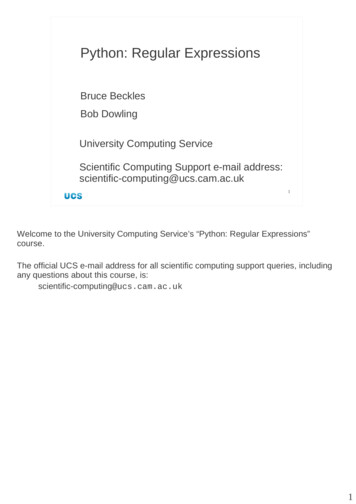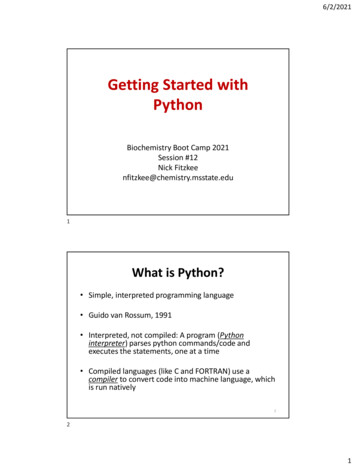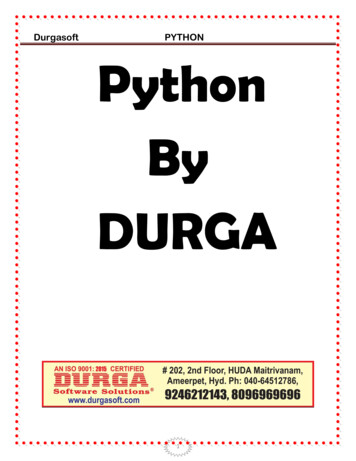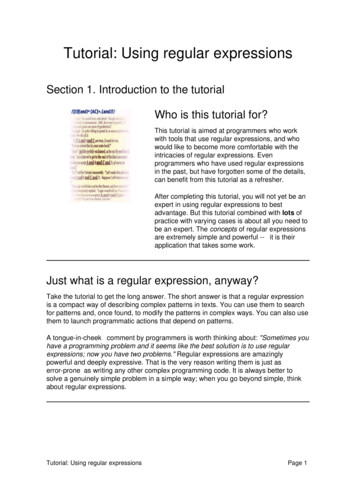
Transcription
Python: Regular ExpressionsBruce BecklesBob DowlingUniversity Computing ServiceScientific Computing Support e-mail address:scientific-computing@ucs.cam.ac.uk1Welcome to the University Computing Service’s “Python: Regular Expressions”course.The official UCS e-mail address for all scientific computing support queries, includingany questions about this course, is:scientific-computing@ucs.cam.ac.uk1
This course:basic regular expressionsgetting Python to use them2Before we start, let’s specify just what is and isn’t in this course.This course is a very simple, beginner’s course on regular expressions. It mostlycovers how to get Python to use them.There is an on-line introduction called the Python “Regular Expression HowTo” at:http://docs.python.org/howto/regexand the formal Python documentation athttp://docs.python.org/library/re.htmlThere is a good book on regular expressions in the O’Reilly series called “MasteringRegular Expressions” by Jeffrey E. F. Freidl. Be sure to get the third edition (or later)as its author has added a lot of useful information since the second edition. There aredetails of this book at:http://regex.info/There is also a Wikipedia page on regular expressions which has useful informationitself buried within it and a further set of references at the end:http://en.wikipedia.org/wiki/Regular Expression2
A regular expression is a“pattern” describing some text:“a series of digits”“a lower case letter followedby some digits”“a mixture of characters except fornew line, followed by a full stop andone or more letters or numbers”\d [a-z]\d . \.\w 3A regular expression is simply some means to write down a pattern describing sometext. (There is a formal mathematical definition but we’re not bothering with that here.What the computing world calls regular expressions and what the strict mathematicalgrammarians call regular expressions are slightly different things.)For example we might like to say “a series of digits” or a “a single lower case letterfollowed by some digits”. There are terms in regular expression language for all ofthese concepts.3
A regular expression is a“pattern” describing some text:\d Isn't this just gibberish?The language ofregular expressions[a-z]\d . \.\w 4We will cover what this means in a few slides time. We will start with a “trivial” regularexpression, however, which simply matches a fixed bit of text.4
Classic regular expression filterfor each line in a file :Python idiomdoes the line match a pattern?how can we tell?if it does, output somethingwhat?“Hey! Something matched!”The line that matchedThe bit of the line that matched5This is a course on using regular expressions from Python, so before we introduceeven our most trivial expression we should look at how Python drives the regularexpression system.Our basic script for this course will run through a file, a line at a time, and compare theline against some regular expression. If the line matches the regular expression thescript will output something. That “something” might be just a notice that it happened(or a line number, or a count of lines matched, etc.) or it might be the line itself.Finally, it might be just the bit of the line that matched.Programs like this, that produce a line of output if a line of input matches somecondition and no line of output if it doesn't are called "filters".5
Task: Look for “Fred” in a list of erickFelicity FredFredaFrederickfreds.txtnames.txt6So we will start with a script that looks for the fixed text “Fred” in the file names.txt.For each line that matches, the line is printed. For each line that doesn't nothing isprinted.6
c.f. grep grep 'Fred' names.txtFredFredaFrederick (Don't panic if you're not a Unix user.)7This is equivalent to the traditional Unix command, grep.Don't panic if you're not a Unix user. This is a Python course, not a Unix one.7
Skeleton Python script ― data flowimport sysfor input & outputimport regular expression moduledefine patternset up regular expressionread in the linesone at a timecompare line to regular expressionfor line in sys.stdin:if regular expression matches:sys.stdout.write(line)write out the8matching linesSo we will start with the outline of a Python script and review the non-regularexpression lines first.Because we are using standard input and standard output, we will import the sysmodule to give us sys.stdin and sys.stdout.We will process the file a line at a time. The Python object sys.stdin correspondsto the standard input of the program and if we use it like a list, as we do here, then itbehaves like the list of lines in the file. So the Python "for line in sys.stdin:"sets up a for loop running through a line at a time, setting the variable line to beone line of the file after another as the loop repeats. The loop ends when there are nomore lines in the file to read.The if statement simply looks at the results of the comparison to see if it was asuccessful comparison for this particular value of line or not.The sys.stdout.write() line in the script simply prints the line. We could just useprint but we will use sys.stdout for symmetry with sys.stdin.The pseudo-script on the slide contains all the non-regular-expression code required.What we have to do now is to fill in the rest: the regular expression components.8
Skeleton Python script ― reg. exps.import sysimport regular expression modulemoduledefine pattern“gibberish”prepare thereg. exp.set up regular expressionfor line in sys.stdin:compare line to regular expressionif regular expression matches:sys.stdout.write(line)use thereg. exp.see whatwe got9Now let's look at the regular expression lines we need to complete.Python's regular expression handling is contained in a module so we will have toimport that.We will need to write the “gibberish” that describes the text we are looking for.We need to set up the regular expression in advance of using it. (Actually that's notalways true but this pattern is more flexible and more efficient so we'll focus on it inthis course.)Finally, for each line we read in we need some way to determine whether our regularexpression matches that line or not.9
Loading the moduleimportreregular expressionsmodule10The Python module for handling regular expressions is called “re”.10
Skeleton Python script ― 1import sysimport reReady to useregular expressionsdefine patternset up regular expressionfor line in sys.stdin:compare line to regular expressionif regular expression matches:sys.stdout.write(line)11So we add that line to our script.11
Defining the patternpattern "Fred"Simple string12In this very simple case of looking for an exact string, the pattern is simply that string.So, given that we are looking for "Fred", we set the pattern to be "Fred".12
Skeleton Python script ― 2import sysimport repattern "Fred"Define the patternset up regular expressionfor line in sys.stdin:compare line to regular expressionif regular expression matches:sys.stdout.write(line)13We add this line to our script, but this is just a Python string. We still need to turn itinto something that can do the searching for "Fred".13
Setting up a regular expressionfrom the re modulecompile the pattern“Fred”regexp re . compile ( pattern )regular expression object14Next we need to look at how to use a function from this module to set up a regularexpression object in Python from that simple string.The re module has a function “compile()” which takes this string and creates anobject Python can do something with. This is deliberately the same word as we usefor the processing of source code (text) into machine code (program). Here we aretaking a pattern (text) and turning it into the mini-program that does the testing.The result of this compilation is a “regular expression object”, the mini program thatwill do work relevant to the particular pattern “Fred”. We assign the name “regexp”to this object so we can use it later in the script.14
Skeleton Python script ― 3import sysimport repattern "Fred"regexp re.compile(pattern)for line in sys.stdin:Prepare theregularexpressioncompare line to regular expressionif regular expression matches:sys.stdout.write(line)15So we put that compilation line in our script instead of our placeholder.Next we have to apply that regular expression object, regexp, to each line as it isread in to see if the line matches.15
Using a regular expressionThe reg. exp. objectwe just prepared.The reg. exp. object'ssearch() method.The text being tested.result regexp.search(line)The result of the test.16We start by doing the test and then we will look at the test's results.The regular expression object that we have just created, “regexp”, has a method (abuilt in function specific to itself) called “search()”. So to reference it in our script weneed to refer to “regexp.search()”. This method takes the text being tested (ourinput line in this case) as its only argument. The input line in in variable line so weneed to run “regexp.search(line)” to get our result.Note that the string “Fred” appears nowhere in this line. It is built in to the regexpobject.Incidentally, there is a related confusingly similar method called “match()”. Don't useit. (And that's the only time it will be mentioned in this course.)16
Skeleton Python script ― 4import sysimport repattern "Fred"regexp re.compile(pattern)for line in sys.stdin:result regexp.search(line)Use thereg. exp.if regular expression matches :sys.stdout.write(line)17So we put that search line in our script instead of our placeholder.Next we have to test the result to see if the search was successful.17
Testing a regular expression's resultsThe result of theregular expression'ssearch() method.SearchsuccessfulSearchunsuccessfultests as Truetests as Falseif result:18The search() method returns the Python “null object”, None, if there is no match andsomething else (which we will return to later) if there is one. So the result variablenow refers to whatever it was that search() returned.None is Python’s way of representing “nothing”. The if test in Python treats None asFalse and the “something else” as True so we can use result to provide us with asimple test.18
Skeleton Python script ― 5import sysimport repattern "Fred"regexp re.compile(pattern)for line in sys.stdin:result regexp.search(line)See if theif result:line matchedsys.stdout.write(line)19So if we drop that line into our skeleton Python script we have completed it.This Python script is the fairly generic filter. If a input line matches the pattern write theline out. If it doesn't don't write anything.We will only see two variants of this script in the entire course: in one we only print outcertain parts of the line and in the other we allow for there being multiple Freds in asingle line.19
Exercise 1(a): complete the fileimport sysimport repattern "Fred"regexp for line in sys.stdin:result if :sys.stdout.write(line)filter01.py5 mins20If you look in the directory prepared for you, you will find a Python script called“filter01.py” which contains just this script with a few critical elements missing.Your first exercise is to edit that file to make it a search for the string 'Fred'.Once you have completed the file, test it.20
Exercise 1(b): test your file python filter01.py names.txtFredFredaFrederick21Note that three names match the test pattern: Fred, Freda and Frederick. If you don'tget this result go back to the script and correct it.21
Case sensitive matchingnames.txtFredFredaFrederickManfred Python matches are case sensitive by default22Note that it did not pick out the name “Manfred” also in the file. Python regularexpressions are case sensitive by default; they do not equate “F” with “f”.22
Case insensitive matchingregexp re.compile(pattern ,options )Options are given as module constants:re.IGNORECASEre.Icase insensitive matchingand other options (some of which we’ll meet later).regexp re.compile(pattern ,re.I )23We can build ourselves a case insensitive regular expression mini-program if we wantto. The re.compile() function we saw earlier can take a second, optionalargument. This argument is a set of flags which modify how the regular expressionworks. One of these flags makes it case insensitive.The options are set as a series of values that need to be added together. We’recurrently only interested in one of them, though, so we can give “re.IGNORECASE”(the IGNORECASE constant from the re module) as the second argument.For those of you who dislike long options, the I constant is a synonym for theIGNORECASE constant, so we can use “re.I” instead of “re.IGNORECASE” if wewish. We use re.I in the slide just to make the text fit, but generally we wouldencourage the long forms as better reminders of what the options mean for when youcome back to this script having not looked at it for six months.23
Exercise 2: modify the script1. Copy filter01.pyfilter02.py2. Edit filter02.pyMake the search case insensitive.3. Run filter02.py python filter02.py names.txt5 mins24Copy your answer to the previous exercise into a new file called “filter02.py”.Edit this new file to make the search case insensitive. This involves a singlemodification to the compile() line.Then run the new, edited script to see different results. cp filter01.py filter02.py gedit filter02.py python filter02.py names.txtFredFredaFrederickManfred24
Serious example:Post-processing program outputRUN 000001 COMPLETED. OUTPUT IN FILE hydrogen.dat.RUN 000002 COMPLETED. OUTPUT IN FILE helium.dat. RUN 000039 COMPLETED. OUTPUT IN FILE yttrium.dat. 1 UNDERFLOWWARNING.RUN 000040 COMPLETED. OUTPUT IN FILE zirconium.dat. 2 UNDERFLOWWARNINGS. RUN 000057 COMPLETED. OUTPUT IN FILE lanthanum.dat. ALGORITHMDID NOT CONVERGE AFTER 100000 ITERATIONS. RUN 000064 COMPLETED. OUTPUT IN FILE gadolinium.dat. OVERFLOWERROR. atoms.log25Now let’s look at a more serious example.The file “atoms.log” is the output of a set of programs which do something involvingatoms of the elements. (It’s a fictitious example, so don’t obsess on the detail.)It has a collection of lines corresponding to how various runs of a program completed.Some are simple success lines such as the first line:RUN 000001 COMPLETED. OUTPUT IN FILE hydrogen.dat.Others have additional information indicating that things did not go so well.RUN 000039 COMPLETED. OUTPUT IN FILE yttrium.dat. 1 UNDERFLOWWARNING.RUN 000057 COMPLETED. OUTPUT IN FILE lanthanum.dat. ALGORITHMDID NOT CONVERGE AFTER 100000 ITERATIONS.RUN 000064 COMPLETED. OUTPUT IN FILE gadolinium.dat. OVERFLOWERROR.Our job will be to unpick the “good lines” from the rest.25
What do we want?The file names for the runs withno warning or error messages.RUN 000016 COMPLETED. OUTPUT IN FILE sulphur .dat.RUN 000017 COMPLETED. OUTPUT IN FILE chlorine .dat.RUN 000018 COMPLETED. OUTPUT IN FILE argon.dat.What pattern does this require?26We will build the pattern required for these good lines bit by bit. It helps to have somelines “in mind” while developing the pattern, and to consider which bits changebetween lines and which bits don't.Because we are going to be using some leading and trailing spaces in our strings weare marking them explicitly in the slides.26
“Literal” textFixed textRUN 000017 COMPLETED. OUTPUT IN FILE chlorine .dat.27The fixed text is shown here. Note that while the element part of the file name varies,its suffix is constant.27
DigitsRUN 000017 COMPLETED. OUTPUT IN FILE chlorine .dat.Six digits28The first part of the line that varies is the set of six digits.Note that we are lucky that it is always six digits. More realistic output might havevarying numbers of digits: 2 digits for “17” as in the slide but only one digit for “9”.28
LettersRUN 000017 COMPLETED. OUTPUT IN FILE chlorine .dat.Sequence oflower caseletters29The second varying part is the primary part of the file name.29
And no more!RUN 000017 COMPLETED. OUTPUT IN FILE chlorine .dat.The line starts here and ends here30What we have described to date matches all the lines. They all start with that samesentence. What distinguishes the good lines from the bad is that this is all there is.The lines start and stop with exactly this, no more and no less.It is good practice to match against as much of the line as possible as it lessens thechance of accidentally matching a line you didn’t plan to. Later on it will becomeessential as we will be extracting elements from the line.30
Building the pattern — 1RUN 000017 COMPLETED. OUTPUT IN FILE chlorine .dat.Start of the line marked with An “anchored” pattern 31We will be building the pattern at the bottom of the slide. We start by saying that theline begins here. Nothing may precede it.The start of line is represented with the “caret” or “circumflex” character, “ ”. is known as an anchor, because it forces the pattern to match only at a fixed point(the start, in this case) of the line. Such patterns are called anchored patterns.Patterns which don’t have any anchors in them are known as (surprise!) unanchoredpatterns.31
Building the pattern — 2RUN 000017 COMPLETED. OUTPUT IN FILE chlorine .dat.Literal textDon't forget the space! RUN 32Next comes some literal text. We just add this to the pattern as is.There’s one gotcha we will return to later. It’s easy to get the wrong number of spacesor to mistake a tab stop for a space. In this example it’s a single space, but we willlearn how to cope with generic “white space” later.32
Building the pattern — 3RUN 000017 COMPLETED. OUTPUT IN FILE chlorine .dat.Six digits[0-9]“any single character between 0 and 9”\d“any digit” RUN \d\d\d\d\d\dinelegant33Next comes a run of six digits. There are two approaches we can take here. A digitcan be regarded as a character between “0” and “9” in the character set used, but it ismore elegant to have a pattern that explicitly says “a digit”.The sequence “[0-9]” has the meaning “one character between “0” and “9” in thecharacter set. (We will meet this use of square brackets in detail in a few slides’ time.)The sequence “\d” means exactly “one digit”.However, a line of six instances of “\d” is not particularly elegant. Can you imaginecounting them if there were sixty rather than six?33
Building the pattern — 4RUN 000017 COMPLETED. OUTPUT IN FILE chlorine .dat.Six digits\d“any digit”\d{6}“six digits”\d{5,7}“five, six or seven digits” RUN \d{6}34Regular expression pattern language has a solution to that inelegance. Following anypattern with a number in curly brackets (“braces”) means to iterate that pattern thatmany times.Note that “\d{6}” means “six digits in a row”. It does not mean “the same digit sixtimes”. We will see how to describe that later.The syntax can be extended:\d{6}six digits\d{5,7} five, six or seven digits\d{5,} five or more digits\d{,7} no more than seven digits (including no digits)34
Building the pattern — 5RUN 000017 COMPLETED. OUTPUT IN FILE chlorine .dat.Literal text(with spaces). RUN \d{6} COMPLETED. OUTPUT IN FILE 35Next comes some more fixed text.As ever, don't forget the leading and trailing spaces.35
Building the pattern — 6RUN 000017 COMPLETED. OUTPUT IN FILE chlorine .dat.Sequence of lower case letters[a-z]“any single character between a and z”[a-z] “one or more characters between a and z” RUN \d{6} COMPLETED. OUTPUT IN FILE [a-z] 36Next comes the name of the element. We will ignore for these purposes the fact thatwe know these are the names of elements. For our purposes they are sequences oflower case letters.This time we will use the square bracket notation. This is identical to the wild cardsused by Unix shells, if you are already familiar with that syntax.The regular expression pattern “[aeiou]” means “exactly one character which can beeither an ‘a’, an ‘e’, an ‘i’, an ‘o’, or a ‘u’”.The slight variant “[a-m]” means “exactly one character between ‘a’ and ‘m’ inclusivein the character set”. In the standard computing character sets (with nointernationalisation turned on) the digits, the lower case letters, and the upper caseletters form uninterrupted runs. So “[0-9]” will match a single digit. “[a-z]” willmatch a single lower case letter. “[A-Z]” will match a single upper case letter.But we don’t want to match a single lower case letter. We want to match an unknownnumber of them. Any pattern can be followed by a “ ” to mean “repeat the pattern oneor more times”. So “[a-z] ” matches a sequence of one or more lower case letters.(Again, it does not mean “the same lower case letter multiple times”.) It is equivalent to“[a-z]{1,}”.36
Building the pattern — 7RUN 000017 COMPLETED. OUTPUT IN FILE chlorine .dat.Literal text RUN \d{6} COMPLETED. OUTPUT IN FILE [a-z] .dat.37Next we have the closing literal text.(Strictly speaking the dot is a special character in regular expressions but we willaddress that in a later slide.)37
Building the pattern — 8RUN 000017 COMPLETED. OUTPUT IN FILE chlorine .dat.End of line marked with RUN \d{6} COMPLETED. OUTPUT IN FILE [a-z] .dat. 38Finally, and crucially, we identify this as the end of the line. The lines with warningsand errors go beyond this point.The dollar character, “ ”, marks the end of the line.This is another anchor, since it forces the pattern to match only at another fixed place(the end) of the line.Note that although we are using both and in our pattern, you don’t have to alwaysuse both of them in a pattern. You may use both, or only one, or neither, dependingon what you are trying to match.38
Exercise 3(a): running the filter1. Copy filter01.pyfilter03.py2. Edit filter03.pyUse the RUN regular expression.3. Test it against atoms.log python filter03.py atoms.log5 mins39You should try this regular expression for yourselves and get your fingers used totyping some of the strange sequences.Copy the filter01.py file that you developed previously to a new file calledfilter03.py.Then edit the simple “Fred” string to the new expression we have developed. Thissearch should be case sensitive.Then try it out for real. cp filter01.py filter03.py gedit filter03.py python filter03.py atoms.logIf it doesn't work, go back and fix filter03.py until it does.39
Exercise 3(b): changing the filter4. Edit filter03.pyLose the at the end of the pattern.5. What output do you think you will get this time?6. Test it against atoms.log again. python filter03.py atoms.log7. Put the back.5 mins40Then change the regular expression very slightly simply by removing the final dollarcharacter that anchors the expression to the end of the line.What extra lines do you think it will match now.Try the script again. Were you right?40
Special codes in regular expressions\A\Z\d\D Anchor start of lineAnchor end of lineAny digitAny non-digit41We have now started to meet some of the special codes that the regular expressionlanguage uses in its patterns.The caret character, “ ”, means “start of line”. The caret is traditional, but there is anequivalent which is “\A”.The dollar character, “ ”, means “end of line” and has a “\Z” equivalent.The sequence “\d” means “a digit”. Note that the capital version, “\D” means exactlythe opposite.41
What can go in “[ ]” ?[aeiou]any lowercase vowel[A-Z]any uppercase alphabetic[A-Za-z]any alphabetic[A-Za-z\]]any alphabetic or a ‘]’backslashed character[A-Za-z\-][-A-Za-z]any alphabetic or a ‘-’any alphabetic or a ‘-’‘-’ as first character:special behaviour for ‘-’ only42We also need to consider just what can go in between the square brackets.If we have just a set of simple characters (e.g. “[aeiou]”) then it matches any onecharacter from that set. Note that the set of simple characters can include a space,e.g. “[ aeiou]” matches a space or an “a” or an “e” or an “i” or an “o” or a “u”.If we put a dash between two characters then it means any one character from thatrange. So “[a-z]” is exactly equivalent to “[abcdefghijklmnopqrstuvwxyz]”.We can repeat this for multiple ranges, so “[A-Za-z]” is equivalent stuvwxyz]”.If we want one of the characters in the set to be a dash, “-”, there are two ways wecan do this. We can precede the dash with a backspace “\-” to mean “include thecharacter ‘-’ in the set of characters we want to match”, e.g. “[A-Za-z\-]” means“match any alphabetic character or a dash”. Alternatively, we can make the firstcharacter in the set a dash in which case it will be interpreted as a literal dash (“-”)rather than indicating a range of characters, e.g. “[-A-za-z]” also means “match anyalphabetic character or a dash”.42
What can go in “[ ]” ?[ aeiou]not any lowercase vowel[ A-Z]not any uppercase alphabetic[\ A-Z]any uppercase alphabeticor a caret43If the first character in the square brackets is a caret (“ ”) then the sense of the term isreversed; it stands for any one character that is not one of those in the squarebrackets.If you want to have a true caret in the set, precede it with a backslash.43
Counting in regular expressions[abc]Any one of ‘a’, ‘b’ or ‘c’.[abc] One or more ‘a’, ‘b’ or ‘c’.[abc]?Zero or one ‘a’, ‘b’ or ‘c’.[abc]*Zero or more ‘a’, ‘b’ or ‘c’.[abc]{6}Exactly 6 of ‘a’, ‘b’ or ‘c’.[abc]{5,7}5, 6 or 7 of ‘a’, ‘b’ or ‘c’.[abc]{5,}5 or more of ‘a’, ‘b’ or ‘c’.[abc]{,7}7 or fewer of ‘a’, ‘b’ or ‘c’.44We also saw that we can count in regular expressions. These counting modifiersappear in the slide after the example pattern “[abc]”. They can follow any regularexpression pattern.We saw the plus modifier, “ ”, meaning “one or more”. There are a couple of relatedmodifiers that are often useful: a query, “?”, means zero or one of the pattern andasterisk, “*”, means “zero or more”.Note that in shell expansion of file names (“globbing”) the asterisk means “any string”.In regular expressions it means nothing on its own and is purely a modifier.The more precise counting is done wit curly brackets.44
What matches “[” ?“[abcd]” matches any one of “a”, “b”, “c” or “d”.What matches “[abcd]”?[abcd]Any one of ‘a’, ‘b’, ‘c’, ‘d’.\[abcd\][abcd]45Now let's pick up a few stray questions that might have arisen as we built that pattern.If square brackets identify sets of letters to match, what matches a square bracket?How would I match the literal string “[abcde]”, for example?The way to mean “a real square bracket” is to precede it with a backslash. Generallyspeaking, if a character has a special meaning then preceding it with a backslashturns off that specialness. So “[” is special, but “\[” means “just an open squarebracket”. (Similarly, if we want to match a backslash we use “\\”.)We will see more about backslash next.45
Backslash[]used to hold sets of characters\[\]the real square bracketsdthe letter “d”\dany digitd\[\]literal characters\\d[]specials46The way to mean “a real square bracket” is to precede it with a backslash. Generallyspeaking, if a character has a special meaning then preceding it with a backslashturns off that specialness. So “[” is special, but “\[” means “just an open squarebracket”. (Similarly, if we want to match a backslash we use “\\”.)Conversely, if a character is just a plain character then preceding it with a backslashcan make it special. For example, “d” matches just the lower case letter “d” but “\d”matches any one digit.46
What does dot match?We’ve been using dot as a literal character.Actually .“.” matches any character except “\n”.\.“\.” matches just the dot.47There’s also an issue with using “.”. We’ve been using it as a literal character,matching the full stops at the ends of sentences, or in file name suffixes but actuallyit’s another special character that matches any single character except for the new linecharacter (“\n” matches the new line character). We’ve just been lucky so far that theonly possible match has been to a real dot. If we want to force the literal character weplace a backslash in front of it, just as we did with square brackets.47
Special codes in regular expressions\A\Z Anchor start of lineAnchor end of line\d\DAny digitAny non-digit.Any character except newline48So we can add the full stop to our set of special codes.48
Building the pattern — 9RUN 000017 COMPLETED. OUTPUT IN FILE chlorine .dat.Actual full stopsin the literal text. RUN \d{6} COMPLETED\. OUTPUT IN FILE [a-z] \.dat\. 49So our filter expression for the atoms.log file needs a small tweak to indicate thatthe dots are real dots and not just “any character except the newline” markers.49
Exercise 4: changing the atom filter1. Edit filter03.pyFix the dots.2. Run filter03.py again to check it. python filter03.py atoms.log50So apply this change to the dots to your script that filters the atoms log.50
Exercise 5 andcoffee breakInput: messagesScript: filter04.pyMatch lines with“Invalid user”.Match the whole line.“Grow” the patternone bit at a time.15 mins51We’ll take a break to grab some coffee. Over the break try this exercise. Copy the file“filter03.py” to “filter04.py” and change the pattern to solve this problem:The file “messages” contains a week’s logs from one of the authors’ workstations. Init are a number of lines containing the phrase “Invalid user”. Write a regularexpression to match these lines and then print them out.Match the whole line, not just the phrase. We will want to use the rest of the line for alater exercise. In addition, it forces you to think about how to match the terms thatappear in that line such as dates and time stamps.This is a complex pattern. We strongly suggest building the pattern one bit at a time.Start with “ [A-Z][a-z]{2} ” to match the month at the start of the line. Get thatworking. Then add the day of the month. Get that working. Then add the next bit andso on.There are 1,366 matching lines. Obviously, that’s too many lines for you to sensiblycount just by looking at the screen, so you can use the Unix command wc to do thisfor you like this:
Python: Regular Expressions Bruce Beckles University Computing Service Bob Dowling Scientific Computing Support e-mail address: . There is a good book on regular expressions in the O'Reilly series called "Mastering Regular Expressions" by Jeffrey E. F. Freidl. Be sure to get the third edition (or later)










